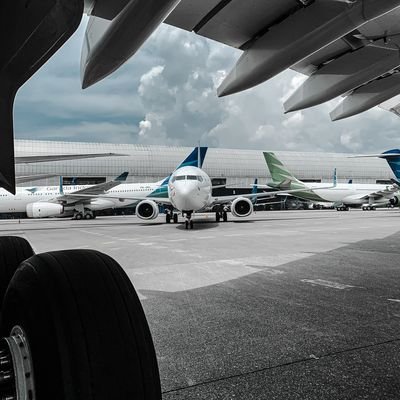Short of carrying your own antibacterial fogger and bombarding where you will be sitting, whenever you step onto a plane, you are going to come face-to-face and hand-to-hand with other people's germs. Unless you are swanning around the pointy end of the plane with a bit of elbow room, you will be up close and personal with your seating companion, sometimes for a very long time. Strangers and bathrooms are never a good mix at the best of times, but more so when in the cramped confines of a plane's amenities.
You can get totally grossed out about it and cancel flights for the rest of your life, become a weirdo and wear rubber gloves constantly changing them, or merely take a few precautionary measures and say a little prayer. The easiest precautionary measure you can do is to always pack in your hand luggage - that will be at your feet - some antibacterial wipes and lotion, plus remember to use them.

People are in general more susceptible to getting sick on planes because of the fact that the air humidity is under 20%. Dry air tackles your mucus membranes, which in fact are your first line of defense to getting sick. It has been touted that you are more likely to catch the common cold during a flight - 113 times more - than when you have both feet on the ground.
The filthy list of dirty spots:
1. Airplane tray tables
Tray tables hit the top of the list and have been found to have nasty bugs such as the cold virus, norovirus (think the runs of the unpleasant sort or the need to leave your head in the toilet bowl), human parainfluenza (bronchitis, croup, and pneumonia), plus the superbug MRSA (skin infections). Lurking on tray tables you will have 8 times more bacteria per square inch than on a toilet flush button. Now that is one very gross area. Wipe, wipe and wipe again with your antibacterial wipes.
Tray tables may be the top of this list but what about the spots Where Germs Hide in Restaurants?
2. Overhead air vent
Don't stress out about bugs flying at you from the vent, it is actually touching the dial where the danger is. The air quality in planes is better than offices or movie theaters, as it is changed every 2 to 3 minutes, so don't be afraid to take that deep breath. Put on your rubber glove or wipe down the dial with your antibacterial wipe before you contemplate touching the dial though, as apparently there is a toilet seat quantity of germs lurking on it.

3. Touchscreens
Another rubber glove zone or antibacterial wiping area; the tempting touchscreen especially the control, if you can get it out of the tight-fit cradle without a fight, so that you can sit back and watch a movie on that long-haul flight. This is definitely a germ alert area to wipe down.
4. Seat belt buckle
The one item that every single person that has sat in your seat has touched, because they are told to, is the seat buckle. This must do action will put you in touch with a humungous amount of bacteria and is a hot spot area for the transference of germs. For a bit of added protection never touch your face after buckling up. Get out the wipes and go to work. You may always want to check How Clean Are Your Airline Seats.
5. The bathroom/restroom/water closet/toilet or whatever you call it
The evil space where germs have an orgy, despite being cleaned on long-haul flights, the bathroom is a germophobe's nightmare. If you are going on a short flight you should always go to do your "business" prior to boarding the plane. For long-haul flights, unless you are wearing an incontinent pad or feel like wetting your pants, it is an entirely different matter. Nature will call upon you at some point and you will have to go that dastardly little box at the back of the plane. On average there are probably around 50 people using the one toilet on a flight, so bathrooms will be literally jumping with cavorting E.coli bugs. The must do is to firstly close the toilet lid before you push the flush button. You should always use paper towel when you flush the toilet, touch the sink or the taps, as well as the door handle. When you are back in your seat get out the sanitizing lotion and smother your hands in it. That is of course if you are not the rubber glove freak - then you will have to change your gloves. Always remember to wear shoes when you head off for a whizz, as the water on the floor may be anything but "water".

6. Seatback pocket
Everyone's rubbish (think dirty tissues and smelly diapers) seems to end up in the pocket of the seat in front of you. Remember germs can last up to 7 days on the cloth covering, so just steer clear of using it.
It's not only dirty seatback pocket you need to worry about, it's also the Bad Behaviour When Flying.
7. Latches on overhead bins
A hotbed for dancing microbes, especially as they seem to be one area that is not frequently cleaned and yet everyone touches them, the latch on the overhead bin is a bacteria magnet. Be smart and travel light so you can put everything at your feet and you don't have to contemplate touching the latch. Also don't forget these Tips on Sharing Overhead Bins.
8. In-flight magazines
Bring your own book or magazine to read and leave the germy magazine alone, especially if it looks a bit on the tatty side. Alternatively check it out online on your tablet or whatever, so that you don't have to touch what someone may have sneezed or coughed over.
9. Plastic window shade
Another place where germs have longevity, the plastic window shade should be approached with rubber gloves, sanitizing wipes or the sleeve of your jumper.

10. Blankets and pillows
Don't share the drool of maybe a prior 100 odd passengers and take your own pillow and blanket, if you like to sleep on a plane. Pillows are cleaned but not on a regular basis and unless a blanket is sealed and straight from the cleaners, never put it near your face if you insist on using it. Cuddling up with germs is what you are trying to avoid. Also remember when you land at your destination to give your pillow and blanket a wash if you have your own, as they would have picked up a few hitchhiking germs from the seat.
11. Rubber armrest
This is the place where E.coli can live for up to 96 hours, so don't bother fighting your seat companions for a bit of the armrest.

12. Leather seat
If you are really concerned about what is lurking on your seat, then wipe it down before you put your rear end on it as little microbes can live there for up to 7 days.
13. Aisle seats -v- window seats
The top of aisle seats are meeting points for germs from everyone that walks past as they grab them for support, with many just coming from the bathroom. If sitting in the aisle is your preferred position, you may wish to rethink this, as you will be the first in the line of fire for any communicable viruses. The window seat actually protects you more from the more aggressive and rampant bugs.
It is a bit of a secret as to how often and how well aircrafts get cleaned in between flights. It is touted that planes are thoroughly cleaned every 30 days of service or at 100 flying hour intervals, but whether this is the case or not, is purely conjecture. So go and fill up your quart-size of liquid allowance with antibacterial sanitizer and be prepared to be the bug-buster on your next flight.
Gail Palethorpe, a self proclaimed Australian gypsy, is a freelance writer, photographer and eternal traveller. Check out her website Gail Palethorpe Photography and her Shutterstock profile.















